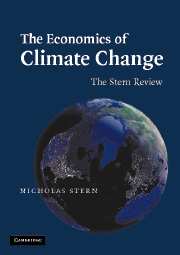Book contents
- Frontmatter
- Contents
- Preface
- Acknowledgements
- Introduction
- Summary of Conclusions
- Part I Climate Change – Our Approach
- Part II Impacts of Climate Change on Growth and Development
- Part III The Economics of Stabilisation
- 7 Projecting the Growth of Greenhouse-Gas Emissions
- 7A Climate Change and the Environmental Kuznets Curve
- 8 The Challenge of Stabilisation
- 9 Identifying the Costs of Mitigation
- 10 Macroeconomic Models of Costs
- 11 Structural Change and Competitiveness
- 11A Key Statistics for 123 UK Production Sectors
- 12 Opportunities and Wider Benefits from Climate Policies
- 13 Towards a Goal for Climate-Change Policy
- Part IV Policy Responses for Mitigation
- Part V Policy Responses for Adaptation
- Part VI International Collective Action
- Abbreviations and Acronyms
- Postscript
- Technical Annex to Postscript
- Index
9 - Identifying the Costs of Mitigation
Published online by Cambridge University Press: 05 March 2014
- Frontmatter
- Contents
- Preface
- Acknowledgements
- Introduction
- Summary of Conclusions
- Part I Climate Change – Our Approach
- Part II Impacts of Climate Change on Growth and Development
- Part III The Economics of Stabilisation
- 7 Projecting the Growth of Greenhouse-Gas Emissions
- 7A Climate Change and the Environmental Kuznets Curve
- 8 The Challenge of Stabilisation
- 9 Identifying the Costs of Mitigation
- 10 Macroeconomic Models of Costs
- 11 Structural Change and Competitiveness
- 11A Key Statistics for 123 UK Production Sectors
- 12 Opportunities and Wider Benefits from Climate Policies
- 13 Towards a Goal for Climate-Change Policy
- Part IV Policy Responses for Mitigation
- Part V Policy Responses for Adaptation
- Part VI International Collective Action
- Abbreviations and Acronyms
- Postscript
- Technical Annex to Postscript
- Index
Summary
KEY MESSAGES
Slowly reducing emissions of greenhouse gasses that cause climate change is likely to entail some costs. Costs include the expense of developing and deploying low-emission and high-efficiency technologies and the cost to consumers of switching spending from emissions-intensive to low-emission goods and services.
Fossil fuel emissions can be cut in several ways: reducing demand for carbon-intensive products, increasing energy efficiency, and switching to low-carbon technologies. Non-fossil fuel emissions are also an important source of emission savings. Costs will differ considerably depending on which methods and techniques are used where.
Reducing demand for emissions-intensive goods and services is part of the solution. If prices start to reflect the full costs of production, including the greenhouse gas externality, consumers and firms will react by shifting to relatively cheaper low-carbon products. Increasing awareness of climate change is also likely to influence demand. But demand-side factors alone are unlikely to achieve all the emissions reductions required.
Efficiency gains offer opportunities both to save money and to reduce emissions, but require the removal of barriers to the uptake of more efficient technologies and methods.
A range of low-carbon technologies is already available, although many are currently more expensive than fossil-fuel equivalents. Cleaner and more efficient power, heat and transport technologies are needed to make radical emission cuts in the medium to long term. Their future costs are uncertain, but experience with other technologies has helped to develop an understanding of the key risks.
[…]
- Type
- Chapter
- Information
- The Economics of Climate ChangeThe Stern Review, pp. 238 - 266Publisher: Cambridge University PressPrint publication year: 2007
- 2
- Cited by



